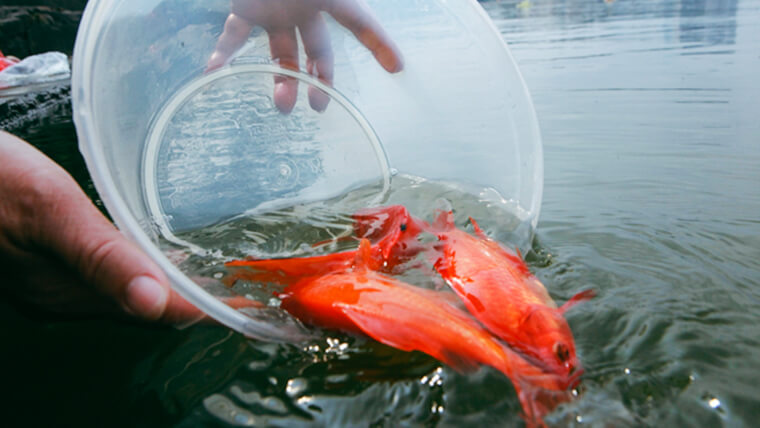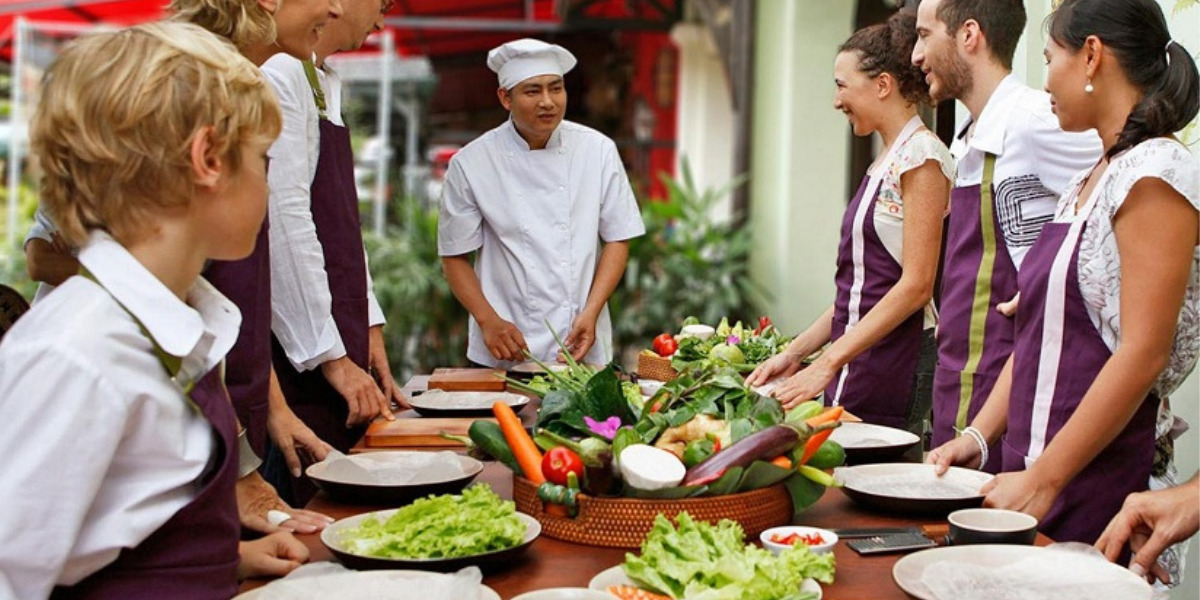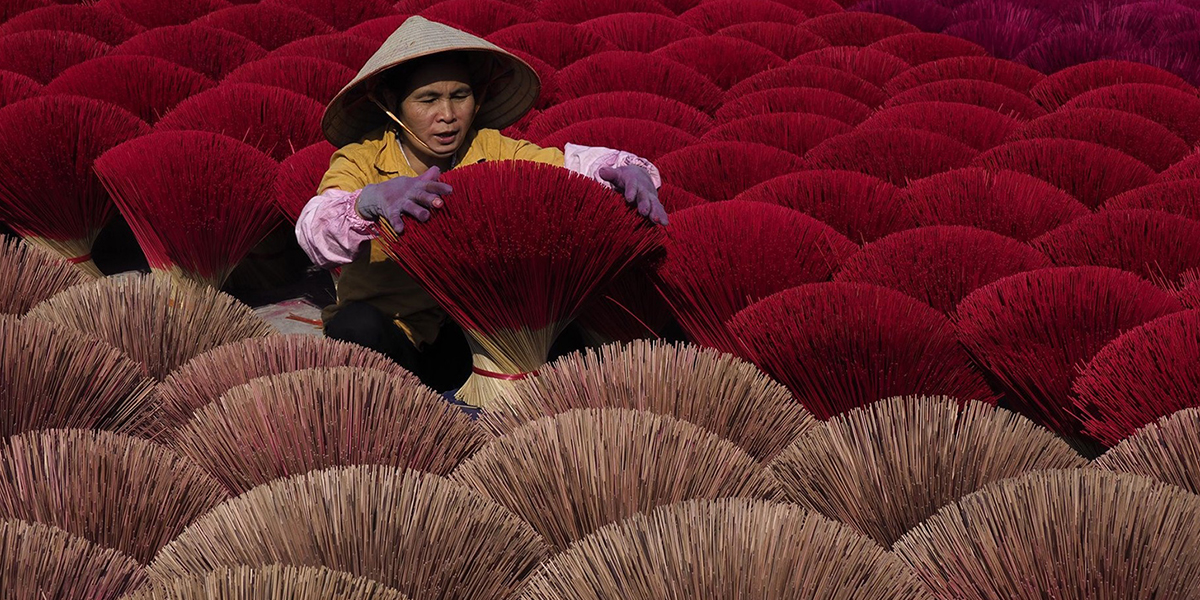Lunar New Year or Tet is the most important holiday in Vietnam and some Asian countries in which many meaningful traditional customs take place with the aim of praying for a peaceful, lucky, and prosperous upcoming year. Normally, there are three stages that are the most paid attention to, including before Tet, New Year’s Eve, and the first three days of the new year, each of which features different atmospheres coming with various activities and Tet traditions to welcome the new year. Let's follow the article below to better understand Vietnamese Lunar New Year traditions.
I - Vietnamese New Year traditions: Before Tet
Because the significant meaning of the Tet holiday has been ingrained in the subconscious of the Vietnamese for thousands of years passed from generation to generation, people are well-prepared for this special occasion. Everyone of all ages is eagerly waiting for Tet and the atmosphere to welcome the coming traditional Lunar New Year becomes bustling and hectic everywhere from urban to rural areas with a myriad of customs and Vietnamese Tet traditions before starting a new year, of which the most common one must be wrapping Banh Chung (Chung cake).
1 - Vietnamese New Year traditions: Wrapping Banh Chung & Banh Tet

Chung cake wrapping - Source: Pinterest
Banh Chung (square glutinous rice cake) is considered the soul of Vietnamese New Year that appears on every altar of Vietnamese people. As an essential element of the family altar during Tet, Banh Chung has appeared during the Tet holiday for such a long time, which expresses gratitude to heaven and earth for favorable weather conditions, abundant harvests, and prosperity and is also considered as the quintessence of wet rice civilization because of all ingredients made of agricultural products. The main ingredients consist of glutinous rice, pork meat, green beans, then all are wrapped in green “dong” leaves in a square shape, and tied with bamboo strings. As one of the Vietnamese New Year traditions, The process of making and boiling Banh Chung is also a precious opportunity for family members to gather around the warm fire to share their stories with one another after a long, hard-working year.
Wrapping Banh Tet is also one of the Vietnamese Tet traditions which is extremely popular in Southern provinces and South Central provinces of Vietnam. Banh Tet is generally similar to Banh Chung in terms of ingredients. However, instead of the square shape, Banh tet is wrapped in a cylindrical shape.
Besides Banh Chung and Banh Tet, other signature Vietnamese Tet dishes are Chả Lụa (pork bologna), Gà Luộc (boiling chicken), Củ Kiệu (pickled scallion or Chinese onion),...
2 - Vietnamese New Year traditions: Kitchen Guardian’s Day

Red carp releasing tradition - Source: vtc.vn
In the beliefs of the Vietnamese, the Kitchen Gods play a very important role in determining the good luck, risk, and the blessing of the homeowners, who protect the whole family from the devil. Therefore, the ceremonial ritual offerings to these Gods are of great significance in people’s spiritual life and is an indispensable Vietnamese Lunar New Year traditions. The practice of worshiping the Kitchen Gods originates from ancient times and takes place on the 23rd of the Lunar December. On this day, all families prepare a tray with three dresses and a special hat to offer to Ong Tao accompanied with three live carps (The carps will be then released in rivers, lakes, or ponds). This custom stems from the belief that the Kitchen Gods will ride carps to heaven and report to the Heaven King about household affairs such as business, relationships,... After this ceremony, families begin tidying and decorating the houses to welcome a new start and good luck to their houses.
3 - Vietnamese New Year traditions: Visiting ancestral tombs

Visiting ancestors' grave - Source: v1.webbnc.net
The Vietnamese people have a long tradition of visiting ancestral graves before Tet to pay tribute to the past generation. It normally takes place from the 23rd of the last month of the lunar year. Family members light incense at the ancestors' graves to invite the deceased to “go back home” to welcome Tet with the offspring. They uproot weeds and clean the gravestones with the belief that everything including the ancestors’ tombs should be cleaned to celebrate the new year so as to have good luck.
4 - Cleaning and decorating houses
Cleaning and decorating houses are also Vietnamese New Year traditions. The Vietnamese usually spend a week before the Tet holiday to clean the house with a belief that clean houses would bring the new start of the upcoming year and “chase away” sadness, afflictions, and worries of the old year. All family members give one another a hand to sweep the floor, backyard, wash mattress and pillow, trim trees neatly, clean tables, chairs, housewares, etc. The most important part of the house that is closely paid attention to is the ancestral altar which is dusted carefully to “invite” the ancestors to “go home”. These Vietnam New Year traditions also mean to welcome the God of Fortune to the house owners so that their family is happier and wealthier in the following year.
5 - Vietnamese New Year traditions: Five-fruit tray

Five fruit tray - Source:vnexpress
The five-fruit tray is an indispensable part placed at the holy place of the house at Tet holiday, which symbolizes the wholeheartedness and piety of the offsprings towards their ancestors. The components of the tray vary from region to the other but in general, it consists of a hand of green bananas, a ripe pomelo or Buddha’s hand, oranges, persimmons, a bunch of kumquats. Despite its name of a five-fruit tray, it does not necessarily have exactly five kinds of different fruits. As one of the Tet traditions in Vietnam, the odd number of fruits represents growth, reproduction, and development. Each type of fruit also carries its own meaning such as banana symbolizing reunion, pomelo for prosperity and good health, persimmon for richness and mandarine for success, kumquat for prosperity and fortune, etc. The arrangement and decoration of the five-fruit tray is a sophisticated art that needs to be harmoniously and beautifully combined between those “elements” in terms of colors and shapes so that the tray can look like a still-life picture.
6 - Vietnamese New Year traditions: Flowers during Tet
One of the necessary elements for house decoration in the Vietnamese Lunar New Year must be flowers. Those colorful flowers in various shapes are symbols of beauty and full of the “energy” of spring. Depending on individual preferences, people can choose different types of flowers to display at home during Tet, in which the two most typical ones are apricot blossom in the South and peach blossom in the North.
As one of the Vietnamese Lunar New Year traditions, the apricot blossom is outstanding with a “slim” but flexible shape with a subtle fragrance, and the bright yellow color symbolizes hope, wealth, and good luck. Pink peach blossom not only makes the atmosphere of the Tet holiday more joyful and cozy but also carries many meanings. It is regarded as the quintessence of the Five Elements that can chase all demons away and bring people a peaceful and happy life. Besides, peach blossoms also represent the fertility and prosperity of the house owners in the new year. The luxuriant kumquat trees full of fruits are also placed in the living room of many houses, which symbolizes peace, good health, longevity, luck, and family reunion as well.
7 - Vietnamese New Year traditions: Cay Neu

Neu tree - studentexchange.vn
Cay Neu or Tet pole is actually a certain kind of tree (such as bamboo or other types of trees in ethnic minorities that are trimmed off branches and leaves) with colorful decorative items hung on it. In the mind of Vietnamese people, especially the ethnic ones, the New Year is the time when the gods return to heaven, so people need other “effective treasure” like the tree in front of their houses to guard against the invasion of evil. Nevertheless, this Tet tradition has gradually disappeared in the Vietnamese community in modern life, replaced by peach blossom or apricot blossoms. It is only found in some ethnic minorities in the northern uplands or the Central Highlands of Vietnam.
II - Vietnamese New Year traditions: New Year’s Eve
1 - Year-end worshiping ceremony

Ancestors worshiping - Souce: tieudung.vn
Every year, in order to end an old year and welcome a new year with plenty of luck to come, Vietnamese people have a custom of offering “Tat Nien”, also called Year End Party as an important milestone. It takes place in the afternoon of the 30th lunar December or 29th lunar December of the leap year. The customs and rituals for this ceremony are different among regions. The owner can invite friends or relatives to their houses to enjoy the year-end party. As one of the Vietnamese Tet traditions, the ceremony is a traditional culture for children to show their gratitude to ancestors, gods, and saints. The offerings for the ceremony are Banh Chung, fresh flower, boiled chicken, betel and areca together with votive paper, etc., all of which are carefully and neatly arranged on the altar and placed in a tray on a table outdoors (depending on certain families). Based on the location of worship (inside or outside the house), the owner will have different prayers.
2 - Vietnamese New Year traditions: Giao Thua Ceremony
After the “Tat Nien” ceremony is the Giao Thua ceremony (New Year’s Eve worshiping ceremony) which takes place correctly at 0pm, the transition moment from the old year and the new one. The oldest man in the family offers incense and reads the prayer to “invite” the ancestors and the Gods to go home and celebrate the New Year with the whole family. Each family has different offerings, but the principal “elements” are various types of fruits, flowers, joss paper (ghost money), Banh Chung, or a five-fruit tray, etc.
3 - Cung Trung Thien
This Vietnamese New Year tradition is considered the last sacred moment of the old year that is about to pass to start a new year. The custom of worshiping Trung Thien is a cultural and religious beauty with the aim of chasing demons and ghosts as well as wishing for a prosperous and happy new year. In addition, people worship the Gods to express their deep respect and gratitude to the God of heaven, the Buddha, and the family’s ancestors.
As one of the Vietnamese New Year traditions, the offerings are placed on a small table in the yard or in the middle of the garden. There are normally a bowl of rice, sticky rice, boiled chicken, boiled pork, fried spring rolls, Banh Chung, wine, votive paper, etc. At the time of worshiping Trung Thien, the owner of the house, usually, the oldest one kneels down or stands in front of the “altar” to sincerely pray to express the gratitude for protecting the family during the past year, simultaneously sending best wishes to the God of Heaven.
4 - Go to the pagoda to pray for good luck

Visiting pagoda is one of the popular Vietnamese Lunar New Year traditions - Source: vietnammoi.vn
This is an indispensable activity of the Vietnamese in the new year, which has become a cultural and spiritual beauty of the country. They often go to pagodas and please calligraphy at midnight on the very first day of the new year aiming at praying for good luck, prosperity, health, and happiness. Like some other Vietnamese New Year traditions, it is believed that going to a pagoda at the beginning of the year also helps people to kick off worries and pressure of the hectic life.
In the past, people used to please a small branch of a young tree to hang it in front of the house or place it on the ancestral altar with the desire to bring prosperity to their house in the upcoming year. However, in modern life, instead of pleasing a branch of a tree, people can please a small red envelope carrying the wishes of the pagoda or maybe a ring or bracelet to bring along with them as a precious thing to protect people from the evils and bring good luck for the owner.
The custom of pleasing calligraphy is also popular in the new year. The image of an old man meticulously writing the wishes on the red paper represents fortune and happiness.
III - Vietnamese New Year traditions: The first days of the new year
The Vietnamese believe that the very first days of the new year have a significant impact on the entire coming year, or even dictate the new year. Therefore, they always pay attention to behaviors and speeches.
3 - Vietnamese New Year traditions red envelope and lucky money

Giving lucky money - Source: eva.vn
The custom of giving lucky money on New Year’s Day is popular not only in Vietnam but also in some Asian countries like China and Japan. Lucky money is wrapped in a red envelope, symbolizing good luck, health, and fortune. Normally, adults give lucky money to children and the old in a couple of first days of the new year. This custom has expanded to the workplace where friends and colleagues can also give each other lucky money for a lucky coming year.
2 - Vietnamese tet traditions: First footing
Xông đất or first footing at the beginning of the new year is an old tradition that has been well preserved from one generation to the other, stemming from the deep-rooted belief that the first person to enter a house at the beginning of a lunar year will bring fortunes or bad luck through that year for the owner. Accordingly, many families find the first-footer a couple of days before the new year, which is based on the person’s zodiac sign and Feng-shui factors. As one of the Vietnamese New Year traditions, the person who first enters the house must match the age of the host and the representative animals of that year. Otherwise, he must be a successful one or an old man who has many children. The first-footer needs to express joyful and positive attitudes to bring a new vibe to the owner’s house. After that, the host and the guest happily congratulate and give the best wishes to each other, then the host invites the first-footer to sip a cup of hot tea and some food.
3 - Tet holiday traditions: Sending best wishes to each other
New Year is a time when people set goals for the upcoming year full of passion and dreams; therefore, the custom of wishing friends and relatives a happy new year at the beginning of the year is considered the fine tradition of Vietnamese people that has existed for thousands of years. As one of the Vietnamese New Year traditions, there is a belief that “Visit paternal side on the first day, maternal side on the second day and teachers on the third day” (mùng 1 tết cha, mùng 2 tết mẹ, mùng 3 tết thầy). Accordingly, on the 1st of lunar January, everyone visits grandparents of father, then the close relatives, the next day is for maternal side, which means the grandparents of mother, and the 3rd day of the new year, Vietnamese people usually pay a visit to their teachers to express their deep gratitude to the people who are dedicated to teaching and educating them. This custom shows the precious tradition of gratitude that can be summed up in the proverb: “when you drink water, think of the source. Here are several popular wishes that are used in the Lunar New Year:
- I wish you a healthy and wealthy new year (Năm mới chúc anh/ chị sức khỏe và tài lộc)
- All wishes come true (Vạn sự như ý)
- Forever young, never gets old (Năm mới trẻ mãi không già)
- I wish you will get promoted in the new year (Chúc bạn thăng tiến trong năm mới)
- Eat more, grow rapidly (Năm mới ăn mau, chóng lớn nhé)
4 - Vietnamese New Year traditions: Festivals

New year festival - Source: vietnammoi.vn
At the beginning of the new year, there are numerous Spring festivals to meet the spiritual needs of people from all regions along the S-shaped country and international tourists as well. The festivals are the occasion for strengthening the bond among communities via fascinating activities and commemorating heroes of the nations. The most famous and large-scale festivals can be mentioned as Huong Pagoda Festival in Hanoi (on lunar January 6th to lunar March), Yen Tu Festival in Quang Ninh in Province (lunar January 10th), Hung Kings Commemoration (lunar March 10th), Bai Dinh Pagoda Festival in Ninh Binh Province,... that has drawn the attention of a large number of locals and international tourists.
Vietnamese New Year traditions partially exude the beauty of the traditional culture of the nation from ancient times. Hopefully, the article below helps you have a broader view of the habits and preparation of the Vietnamese for the lunar new year. Wish you all a happy new year with loved ones!







.jpg) — Ha Bich
— Ha Bich




































